Originally posted on sciy.org by Rich Carlson on Wed 11 Mar 2009 06:29 PM PDT
BioArt is an art practice in which the medium is living matter and the works of art are produced in laboratories and/or artists’ studios. The tool is biotechnology, which includes such technologies as genetic engineering, tissue culture and cloning. BioArt is considered by most artists to be strictly limited to “living forms,†although there is some debate as to the stages at which matter can be considered to be alive or living. The materials used by Bioartists are cells, DNA, proteins and living tissue. Creating living beings and practicing in the life sciences brings about ethical, social and aesthetic inquiry. The phrase "BioArt" was coined by Eduardo Kac in 1997 in relation to his artwork "Time Capsule". Although it originated at the end of the 20th century through the works of pioneers like Kac and Gessert, BioArt started to be more widely practiced in the beginning of the 21st Century. Thus, it may be considered the first 21st century art movement.
Genesis

Genesis is a transgenic artwork that explores the intricate relationship between biology, belief systems, information technology, dialogical interaction, ethics, and the Internet. The key element of the work is an "artist's gene", a synthetic gene that was created by Kac by translating a sentence from the biblical book of Genesis into Morse Code, and converting the Morse Code into DNA base pairs according to a conversion principle specially developed by the artist for this work. The sentence reads: "Let man have dominion over the fish of the sea, and over the fowl of the air, and over every living thing that moves upon the earth." It was chosen for what it implies about the dubious notion--divinely sanctioned--of humanity's supremacy over nature. Morse code was chosen because, as the first example of the use of radiotelegraphy, it represents the dawn of the information age--the genesis of global communication. The Genesis gene was incorporated into bacteria, which were shown in the gallery. Participants on the Web could turn on an ultraviolet light in the gallery, causing real, biological mutations in the bacteria. This changed the biblical sentence in the bacteria. After the show, the DNA of the bacteria was translated back into Morse code, and then back into English. The mutation that took place in the DNA had changed the original sentence from the Bible. The mutated sentence was posted on the Genesis web site. In the context of the work, the ability to change the sentence is a symbolic gesture: it means that we do not accept its meaning in the form we inherited it, and that new meanings emerge as we seek to change it.
Move 36

Eduardo Kac
According to Kasparov, Deep Blue's quintessential moment in game two came at Move 36. Rather than making a move expected by viewers and commentators alike--a sound move that would have afforded immediate gratification--it made a move that was subtle and conceptual and, in the long run, better. Kasparov could not believe that a machine had made such a keen move. The game, in his mind, was lost.
The installation presents a chessboard made of earth (dark squares) and white sand (light squares) in the middle of the room. There are no chess pieces on the board. Positioned exactly where Deep Blue made its Move 36 is a plant whose genome incorporates a new gene that I created specifically for this work. The gene uses ASCII (the universal computer code for representing binary numbers as Roman characters, on- and off-line) to translate Descartes's statement: "Cogito ergo sum" (I think therefore I am) into the four bases of genetics.
Through genetic modification, the leaves of the plants curl. In the wild these leaves would be flat. The "Cartesian gene" was coupled with a gene that causes this sculptural mutation in the plant, so that the public can see with the naked eye that the "Cartesian gene" is expressed precisely where the curls develop and twist.
The "Cartesian gene" was produced according to a new code I created especially for the work. In 8-bit ASCII, the letter C, for example, is: 01000011. Thus, the gene is created by the following associations between genetic bases and binary digits:
A = 00
C = 01
G = 10
T = 11
The result is the following gene with fifty-two bases:
CAATCATTCACTCAGCCCCACATTCACCCCAGCACTCATTCCATCCCCCATC
The creation of this gene is a critical and ironic gesture, since Descartes considered the human mind a "ghost in the machine" (for him the body was a "machine"). His rationalist philosophy gave new impetus both to the mind-body split (Cartesian dualism) and to the mathematical foundations of current computer technology.
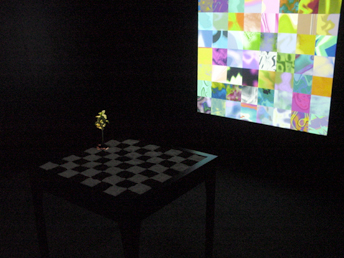
Eduardo Kac, "Move 36", 2004.
The presence of this "Cartesian gene" in the plant, rooted precisely where the human lost to the machine, reveals the tenuous border between humanity, inanimate objects endowed with lifelike qualities, and living organisms that encode digital information. A single parallel light beam shines delicately over the plant. Silent square video projections on two opposing walls contextualize the work, evoking two chess opponents in absentia. Each video projection is composed of a grid of small squares, resembling a chessboard. Each square shows short animated loops cycling at different intervals, thus creating a complex and carefully choreographed thread of movements. The cognitive engagement of the viewer with the multiple visual possibilities presented on both projected boards subtly emulates the mapping of multiple paths on the board involved in a chess match.
A game for phantasmic players, a philosophical statement uttered by a plant, a sculptural process that explores the poetics of real life and evolution. This installation gives continuity to my ongoing interventions at the boundaries between the living (human, non-human animals) and the nonliving (machines, networks). Checkmating traditional notions, nature is revealed as an arena for the production of ideological conflict, and the physical sciences as a locus for the creation of science fictions.
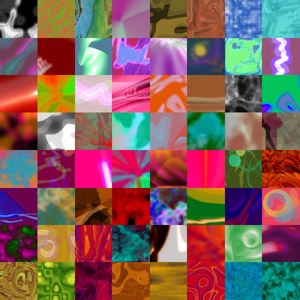 |
 |
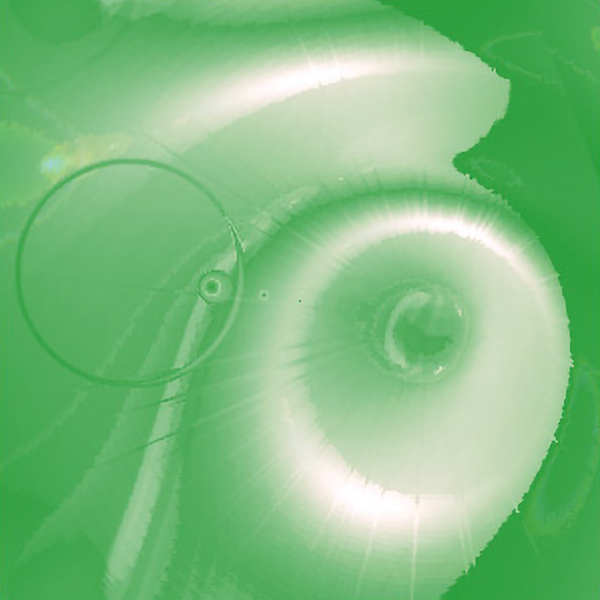 |
| Eduardo Kac, "Move 36", 2004, still from left wall animated loop. | Eduardo Kac, "Move 36", 2004, detail of left wall video projection |
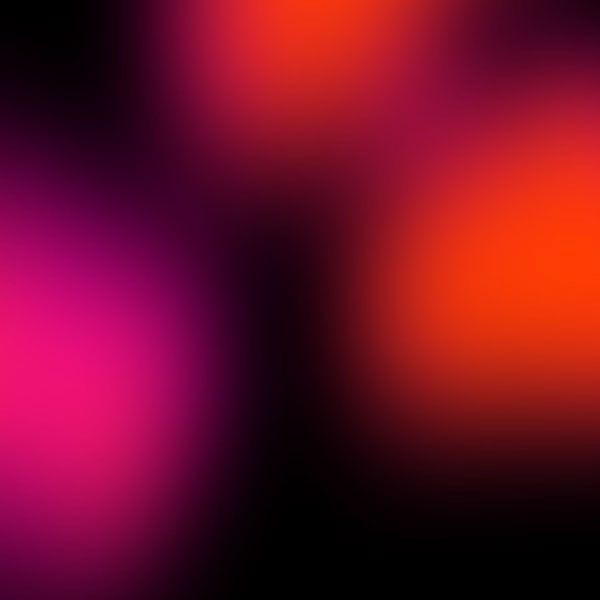 |
 |
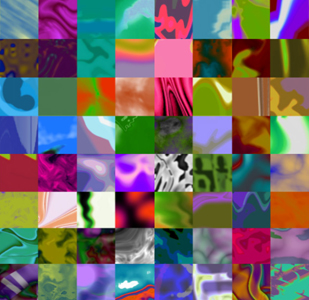 |
| Eduardo Kac, "Move 36", 2004, detail of right wall video projection. |
Eduardo Kac, "Move 36", 2004, still from right wall animated loop. |
EDUARDO KAC
Chronological Biography
| 1962 | Born in Rio de Janeiro, Brazil |
| 1980 | Creates a performance group focused on public interventions and performs regularly on beaches, squares, theaters, television |
| 1982 | Conclusion of performance series on Ipanema beach Experiments with multiple media and processes, including graffiti, photography, visual poetry, artist's book, rubber stamps, photocopiers, clothing, billboards |
| 1983 | Invention of Holopoetry; creation of first holopoem Publication of artist's book "Escracho" |
| 1984 | Participates in the landmark exhibition "Como Vai Você, Geração 80?", at Escola de Artes Visuais do Parque Lage, Rio de Janeiro |
| 1985 | First Holopoetry solo show, at Museum of Image and Sound, São Paulo Presents online pieces in the Brazilian digital network (videotext aka minitel, a precursor of the Internet) Acquisition Award at the National Salon of Fine Arts, Museum of Modern Art, Rio de Janeiro Finishes his studies in communications theory, linguistics, philosophy and semiotics at Rio's Catholic University Shows holopoetry in a group exhibition at The School of The Art Institute of Chicago. |
| 1986 | Organizes the group show "Brasil High Tech" at the Galeria Centro Empresarial Rio, Rio de Janeiro First telepresence work with wireless radio-controlled robot shown at "Brasil High Tech" ; participants could converse with the public through the body of the mobile robot Resident Artist at the Museum of Holography, New York |
| 1987 | Works with fax, televison, Slow Scan TV (aka videophone) |
| 1988 | Holopoetry solo show at Funarte, Rio de Janeiro Studies philosophy and contemporary theory at Universidade Federal, Rio de Janeiro |
| 1989 | Moves to Chicago Creates the Ornitorrinco telepresence project (with Ed Bennett) |
| 1990 | First international Ornitorrinco event, linking Chicago and Rio de Janeiro Solo show, Museum of Holography, New York Master of Fine Arts, The School of The Art Institute of Chicago, Chicago |
| 1992 | "Ornitorrinco in Copacabana", shown at Siggraph Art Show, Chicago |
| 1993 | "Ornitorrinco on the Moon", shown at Künstlerhaus, Graz, Austria, linking Chicago to Graz |
| 1994 | First
wireless telerobotic artwork on the Internet: "Ornitorrinco in Eden",
shown online and simultaneously in galleries in Chicago, Lexington
(KY), and Seattle First bio artwork: "Essay Concerning Human Understanding" (a telecommunications piece conceived for a bird and plant, not humans) |
| 1995 | "Escracho" enters the collection of the Museum of Modern Art, New York Develops the "Telepresence Garment" |
| 1996 | "Ornitorrinco,
the Webot, travels around the world in eighty nanoseconds going from
Turkey to Peru and back", shown on the Internet and at Otso Gallery, in
Espoo, Finland "Ornitorrinco in the Sahara", shown at St. Petersburg Biennale, in Russia, linking Chicago and St. Petersburg "Rara Avis" premieres on the Internet and at Nexus Contemporary Art Center, Atlanta "Teleporting An Unknown State" premieres on the Internet and at the Contemporary Art Center, New Orleans Kac's anthology "New Media Poetry" is published as a special issue of the journal Visible Language |
| 1997 | "A-positive" (with Ed Bennett) premieres at Gallery 2, Chicago First microchip implant tracked online: "Time Capsule" is presented live on televison, as a webcast, and at Casa das Rosas, a cultural center in São Paulo. The international press debates its social and cultural implications. |
| 1998 | First proposes transgenic art Publishes "Transgenic Art" text in Leonardo Electronic Almanac proposing the creation of a green fluorescent dog and its social integration "Teleporting An Unknown State - Web Version" premieres on the Internet and at Kibla Art Gallery, Maribor, Slovenia |
| 1999 | "Darker Than Night" is shown in a bat cave at the Rotterdam Zoo, as part of the exhibition "Fables of a Technological Era" First transgenic artwork: "Genesis" premieres at Ars Electronica, Linz, Austria, and on the Internet Presents and discusses transgenic art in a lecture at Ars Electronica, generating controversy in the international press. "Uirapuru" premieres at ICC Biennial, InterCommunication Center, Tokyo, and on the Internet |
| 2000 | Alba, the green fluorescent rabbit, is born in Jouy-en-Josas, France, as part of the work "GFP Bunny" "GFP Bunny" presented publicly at Grenier à Sel, in Avignon, in the context of the Avignon Numerique festival Front page article on "GFP Bunny" in the "Boston Globe" starts international press chain reaction and provokes global debates on the social presence of genetically engineered organisms and their cultural implications. "Genesis" is shown at Itau Cultural Center, São Paulo Fellowship (Phase I) at Institute for Studies in the Arts, Arizona State University, Tempe, to develop "The Eighth Day" "Genesis" is shown at Exit Art, New York The book "Eduardo Kac: Telepresence, Biotelematics, Transgenic Art" is published. |
| 2001 | Solo exhibition at Julia Friedman Gallery, Chicago "Teleporting an Unknown State" is shown as part of the travelling exhibition "Telematic Connections: The Virtual Embrace", organized by Independent Curators International (ICI), New York, and curated by Steve Dietz. Fellowship (Phase II) at Institute for Studies in the Arts, Arizona State University, Tempe, to exhibit "The Eighth Day" "The Eighth Day" is shown Arizona State University, Tempe "Genesis" is shown at the Yokohama Triennial, Japan "Genesis" is shown at the Fundación Telefonica, Madrid "Free Alba!" photo series shown at Kaohsiung Museum of Fine Arts, Taiwan |
| 2002 | "Free Alba!", solo exhibition at Julia Friedman Gallery, Chicago "Genesis" is shown at Henry Art Gallery, Seattle "Genesis" is shown at Maison Européenne de la Photographie, Paris |
| 2003 | Ronald
Feldman Fine Arts, New York, "American Dream: A Survey" ("Free Alba!"
photographs, t-shirts, "It's not easy being green!" artist's book) Lieu Unique, "L'Art Biotech", Nantes, France ("Free Alba!" photographs,, "Transcription Jewels", "The Eighth Day" video", "Free Alba!" posters) Public art commission for the University of Minnesota, MN The book "The Eighth Day: The Transgenic Art of Eduardo Kac" is published |
| 2004 | "Move 36" is shown at Gwangju Biennale, Korea, and at XXVI Bienal de São Paulo, Brazil "Rabbit Remix" solo exhibition at Laura Marsiaj Arte Contemporânea, Rio de Janeiro Kac's book "Luz & Letra : Ensaios de arte, literatura e comunicação [Light & Letter. Essays in art, literature and communication]" is published by Editora Contra Capa, Rio de Janeiro |
| 2005 | "Move 36" solo exhibition at Galerie Biche de Bere, Paris Kac's book "Telepresence and Bio Art: Networking Humans, Rabbits, and Robots" is published by University of Michigan Press, Ann Arbor The book "Eduardo Kac : Move 36", edited by Elena Giulia Rossi, is published by Filigranes Éditions, Paris (French/English) |
| 2006 | Solo show at ARCO 2006, Madrid, with Black Box Gallery, Copenhagen "Time Capsule" receives the ARCO/BEEP Acquisition Award at ARCO 2006, Madrid Solo exhibition at Fundación Telefónica, Buenos Aires Solo show at Scope art fair, New York, with Ashley Gallery, Philadelphia Solo show at SLICK art fair, Paris, with Ashley Gallery, Philadelphia Participation in the Singapore Biennial, Singapore, with "Specimen of Secrecy about Marvelous Discoveries" Lives and works in Paris between 2006 and 2007 |
| 2007 | Mid-career
survey at Instituto Valenciano de Arte Moderno (IVAM), Valencia, Spain,
with catalogue [curator: Angel Kalenberg]; "Time Capsule" online event
during the opening celebrates 10th anniversary of microchip implant "Specimen of Secrecy about Marvelous Discoveries" : solo show at Fringe Exhibitions, Los Angeles Solo show at ARCO 2007 with Laura Marsiaj Gallery Kac's book "Hodibis Potax," collecting Kac's experimental poetry, is published by Action Poétique (France) and Kibla (Slovenia) in English and French Kac's book "Signs of Life: Bio Art and Beyond", is published by MIT Press Kac's book "Media Poetry: an International Anthology" (2nd edition; 1st edition 1996), is published by Intellect, Bristol, UK Kac's book "Life Extreme," in collaboration with Avital Ronell, is published by Dis Voir, Paris, as separate English and French editions The monograph "L'art à l'ère des biotechnologies: La question du vivant dans l'art transgénique d'Eduardo Kac" [Art in the Biotech Age: The Transgenic Art of Eduardo Kac], by Mathieu Noury, is published by Le Manuscrit, Paris. |
| 2008 | Kac’s
permanent public sculpture “Natural History of the Enigma†is installed
in St. Paul, Minnesota (commissioned by the University of Minnesota) Visiting Artist at Le Fresnoy, France Publication of the DVD "Eduardo Kac: Holopoèmes, Poèmes minitel, poèmes numériques, Biopoèmes:, Son@rt, Paris |
|
|
|
| 2009 | Solo show at the Weisman Art Museum, Minneapolis Solo show at Center for Contemporary Art, Gdansk, Poland "Genesis" is shown at Espace Sextius, during the Seconde Nature Festival, in Aix-en-Provence, France, celebrating ten years of non-stop exhibition of this work Visiting Artist at Le Fresnoy, France; Kac's commission is exhibited in the show "Panorama" The book "Eduardo Kac : El creador de seres imposibles", edited by Andrés Burbano, is published by Universidad de Caldas, Manizales, Colombia. The Spanish translation of Kac's book "Telepresence and Bio Art" is published in Spain by Cendeac |
| 2010 | Solo Show at Laura Marsiaj Arte Contemporânea, Rio de Janeiro Solo show curated by Christiane Paul, Oi Futuro, Rio de Janeiro The bi-lingual book book “Eduardo Kac†(English-Portuguese) is published by Oi Futuro and Contra Capa Hodibis Potax is published by Contra Capa, Rio de Janeiro (English-French-Portuguese) |
|
|
|
| Many
grants, awards and residencies including Creative Capital (New York),
ArtsLink (New York), Illinois Arts Council (Chicago), The Daniel
Langlois Foundation (Montreal), Leonardo Award for Excellence (San
Francisco), InterCommunication Center Biennale '99 Award (Tokyo),
Greenwall Foundation (New York), ARCO/BEEP Acquisition Award (Madrid),
Le Ministère de la culture (Paris), Le Fresnoy (France) |
|
Attachment:







